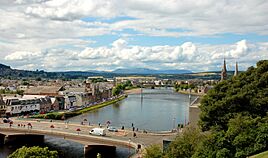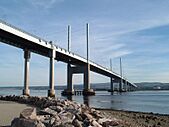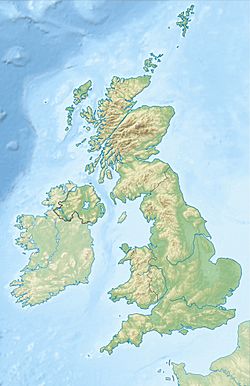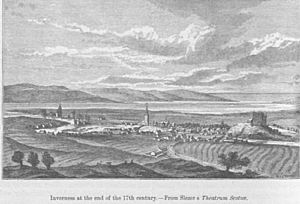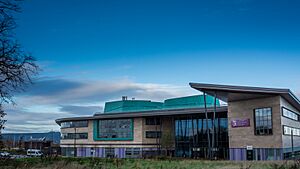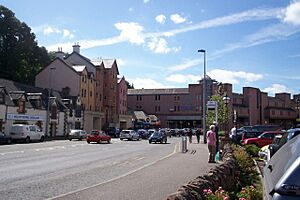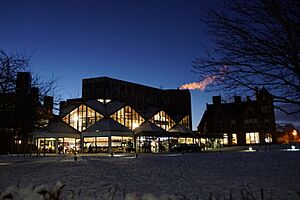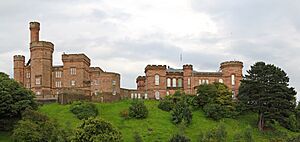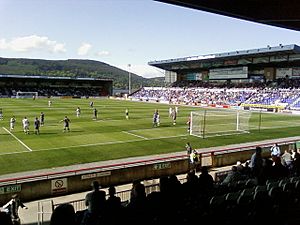Inverness facts for kids
Quick facts for kids
Inverness
|
|
|---|---|
| City of Inverness | |
|
|
|
| Lua error in Module:Location_map at line 420: attempt to index field 'wikibase' (a nil value).
Location within the Highland council area
|
|
| Council area | Highland |
| UK Parliament | Inverness, Skye and West Ross-shire |
| Scottish Parliament | Constituency: Inverness and Nairn Region: Highlands and Islands |
| Historic county | Inverness-shire |
| Country | Scotland |
| Sovereign state | United Kingdom |
| First settled | Before the 6th century AD |
| Royal Charter | C. 12th Century AD |
| City status | 2000 |
| Area | |
| • Locality | 24.3 km2 (9.4 sq mi) |
| • Urban | 31.3 km2 (12.1 sq mi) |
| Population
(2020)
|
|
| • Locality | 47,790 |
| • Rank | 12th, Scotland |
| • Density | 1,967/km2 (5,094/sq mi) |
| • Urban | 63,730 |
| • Urban density | 2,036/km2 (5,273/sq mi) |
| • Metro | 81,968 |
| • Language(s) | English Scots Gaelic |
| Demonym(s) | Invernesian |
| Postcode | |
| Area code(s) | 01463 |
Inverness (pronounced "In-ver-NESS") is a city in the Scottish Highlands. It was officially made a city in the year 2000. It's known as the capital of the Highlands and is where the local council meets.
Inverness is located near the River Ness, which flows into the Beauly Firth. It's also close to the Great Glen, a long valley that stretches across Scotland. The city has a long history, with people living here since at least the 6th century. The first official document giving it special rights was in the 12th century. Inverness is also famous for being near two important battle sites: Blàr nam Fèinne in the 11th century and the Battle of Culloden in the 18th century.
The city has been growing quickly. Its population increased from about 40,000 in 2001 to over 63,000 in 2016. In fact, it's one of Europe's fastest-growing cities! In 2008, Inverness was even ranked as one of the best places to live in Britain.
Contents
- Discovering Ancient Inverness
- Inverness Through the Ages
- Understanding Inverness's Names
- Inverness's Population Growth
- Geography of Inverness
- Inverness's Economy
- Education in Inverness
- Getting Around Inverness
- Culture and Entertainment in Inverness
- Sports and Fun in Inverness
- Famous People from Inverness
- Images for kids
- See also
Discovering Ancient Inverness
Much of what we know about Inverness's past comes from digging up old sites before new buildings are constructed. This is called archaeology.
Early Human Life in Inverness
Between 2009 and 2010, archaeologists found signs that people lived in the Inverness area as far back as 6500 BC. This was during the Late Mesolithic period, also known as the Middle Stone Age. They found evidence of people living and working there for thousands of years, right up to the Late Iron Age (around 1 AD). Most of this activity happened in the Early Neolithic period (4th millennium BC), when farming began.
Archaeologists also found a piece of flint from Yorkshire, showing that people in Inverness might have traded with others far away during the Neolithic period.
Bronze and Iron Age Discoveries
From 1996 to 1997, more excavations took place in western Inverness. They found a Bronze Age burial ground in 1996. The next year, they uncovered a Bronze Age settlement and an Iron Age settlement. At the Iron Age site, they found an ironsmith's workshop, which is one of the earliest examples of iron working in Scotland.
They also found Roman brooches from the 1st and 2nd centuries AD at the Iron Age settlement. This tells us that people in Inverness traded with the powerful Roman Empire. The Bronze Age site also showed signs of metal production, with tools used for making swords. A large silver chain, weighing about 93 ounces (2.6 kg) and dating from 500–800 AD, was found near Torvean in 1809.
Inverness Through the Ages
The Pictish Era
Inverness was an important place for the Picts, an ancient people of Scotland. In 569 AD, St Columba, a famous Irish monk, visited Inverness. He wanted to convert the Pictish king, Brude, to Christianity. It's believed King Brude lived in a strong fort on Craig Phadrig, a hill on the edge of the city.
Early Celtic monks might have built a church or a small cell on St Michael's Mount, a hill near the river. Today, the Old High Church and its graveyard stand on this historic spot.
Medieval Times
Inverness received its first official royal charter from King David I in the 12th century. This document gave the town special rights and freedoms.
The famous Scottish king Macbeth, who lived in the 11th century, had a castle in Inverness. He ruled the area as the Mormaer of Moray and Ross. Later, King Malcolm III is said to have built Inverness Castle after destroying Macbeth's old castle.
Inverness's important location led to many battles. A battle between Malcolm III and Thorfinn the Mighty supposedly happened in the early 11th century at Blar Nam Feinne, southwest of the city.
William the Lion (who died in 1214) gave Inverness four charters, making it a royal burgh. This meant it had special trading rights. From a Dominican monastery founded in 1233, only one pillar and a worn statue of a knight remain today.

During the Middle Ages, Inverness was often attacked by people from the Hebrides, especially the MacDonald Lords of the Isles. In 1187, a battle took place at Torvean, where islanders fought against men from Inverness Castle. Both leaders died.
Local stories say that the citizens of Inverness fought off the Clan Donald in 1340 at the Battle of Blairnacoi. In 1411, Donald of Islay, Lord of the Isles captured and burned the town's bridge over the River Ness. Later, in 1427, King James I held a meeting at the castle, where he arrested some northern leaders who defied him.
In 1454, Clan Munro defeated Clan Mackintosh at the Battle of Clachnaharry, just west of the city. The Clan Donald also attacked the castle in 1491.
Later History
In 1562, Mary, Queen of Scots, visited Inverness. The castle governor, who supported a rival group, refused to let her in. She later had him executed. The Clan Munro and Clan Fraser of Lovat then captured the castle for her.
Oliver Cromwell, a powerful English leader, built a large fort in Inverness that could hold 1,000 soldiers. Most of it was torn down later, but a clock tower in the Citadel area is sometimes called Cromwell's Tower. It was actually part of an old factory built around 1765.
Inverness was also involved in the Jacobite rising of 1689. Jacobite forces attacked the town, but they were eventually stopped by their own commander, Viscount Dundee.
18th and 19th Century Events
In 1715, the Jacobites used the royal fortress as a barracks. In 1727, the government built the first Fort George here. However, in 1746, the Jacobites took it over and blew it up.
The famous Battle of Culloden in 1746, which ended the Jacobite rising, took place near Inverness.
In 1783, a poet named Cionneach MacCionnich wrote a Gaelic poem called The Lament of the North. In it, he criticized wealthy landowners for forcing their tenants off the land to make way for sheep. He also suggested that Scottish Gaels should move to the New World.
Modern Inverness
Inverness has seen a lot of economic growth in the 21st century. Between 1998 and 2008, the area had the biggest growth in economic productivity per person in Scotland.
In 2014 and 2015, surveys found Inverness to be the happiest place in Scotland and one of the happiest in the UK.
Some residents of Inverness have expressed that they would prefer the title "Earl of Inverness" not be associated with Prince Andrew, Duke of York, believing it's not suitable for their city.
Understanding Inverness's Names
Inverness and the surrounding area have many place names that come from the Scottish Gaelic language. This is because Gaelic was widely spoken here until the late 1800s.
For example, "Inverness" itself comes from the Gaelic "Inbhir Nis," which means "Mouth of the River Ness." Many other local names also have Gaelic origins, describing features like hills, rivers, or old settlements.
Healing Springs and Lost Names
Around Inverness, there are several springs that people traditionally believed had healing powers. For instance, Fuaran Dearg (the "Red Spring") was thought to be good for health. Fuaran a' Chladaich ("The Spring on the Beach") was known for treating cholera.
Some Gaelic place names are no longer used because the features they described have disappeared or been forgotten. For example, An Loch Gorm (The Turquoise Loch), a small sea loch, was filled in during the 19th century.
Gaelic in Inverness Today
Historically, most people in Inverness spoke Scottish Gaelic. However, after the 1872 Education Act, the number of Gaelic speakers declined, like in many other parts of the Highlands.
Despite this, Inverness still has a good number of Gaelic speakers today. According to the 2011 census, about 4.8% of people in greater Inverness speak Gaelic. This is higher than the national average for Scotland.
Gaelic is slowly making a comeback in Inverness. You can see it on some signs around the city. The Bun-sgoil Ghàidhlig Inbhir Nis, a primary school that teaches in Gaelic, opened in 2007 and has been very popular. Bòrd na Gàidhlig, an organization that supports Gaelic, has its main office in Inverness. The city also hosted the Royal National Mòd in 2014, a big festival celebrating Gaelic culture.
Inverness's Population Growth
Inverness has seen its population grow steadily over the years.
| Year | Greater Inverness | Inverness |
|---|---|---|
| 2021 | 65,210 | 47,820 |
| 2018 | 64,350 | 47,380 |
| 2016 | 63,220 | 47,290 |
| 2012 | 59,910 | 46,870 |
| 2010 | 57,960 | 45,050 |
| 2008 | 56,660 | 44,220 |
| 2006 | 54,070 | 42,400 |
| 2004 | 52,530 | 40,880 |
| 2003 | 51,610 | 40,470 |
| 2001 | 46,944 | 40,949 |
| 1991 | 44,903 | 40,918 |
| 1981 | 43,246 | 40,011 |
| 1971 | 34,839 | |
| 1961 | 29,774 | |
| 1951 | 28,107 | |
| 1881 | 17,365 | |
| 1871 | 14,469 | |
| 1861 | 12,509 | |
| 1841 | 10,663 | |
| 1831 | 14,324 | |
| 1821 | 12,264 | |
| 1811 | 10,750 | |
| 1801 | 8,732 | |
| 1791 | 7,930 |
Geography of Inverness
Inverness is located where the River Ness meets the Moray Firth. The river flows from the famous Loch Ness, home of the legendary monster! The city is also at the end of the Great Glen, a long valley that stretches across Scotland.
The Ness Islands are a beautiful public park with two wooded islands connected by footbridges. People have enjoyed these islands since the 1840s. Craig Phadraig, a hill that was once an ancient fort, offers great hikes and views.
Inverness is built on the Great Glen Fault, a major crack in the Earth's crust. Small earthquakes happen here about every three years, but they are usually so minor that locals don't even notice them. The last noticeable earthquake was in 1934.


Inverness Climate and Weather
Inverness has an oceanic climate, meaning it has mild temperatures and rain throughout the year. It's generally cooler here than in southern parts of Britain.
The highest temperature ever recorded was 29.7°C (85.5°F) in July 2006 and June 2018. The lowest was -18.7°C (-1.7°F) in January 2010. On a typical warm day, the temperature reaches about 25°C (77°F), and on a cold night, it might drop to around -11°C (12°F).
| Climate data for Inverness, elevation: 13 m (43 ft), 1991–2020 normals, extremes 1960–present | |||||||||||||
|---|---|---|---|---|---|---|---|---|---|---|---|---|---|
| Month | Jan | Feb | Mar | Apr | May | Jun | Jul | Aug | Sep | Oct | Nov | Dec | Year |
| Record high °C (°F) | 11.9 (53.4) |
12.7 (54.9) |
19.4 (66.9) |
23.7 (74.7) |
26.6 (79.9) |
29.7 (85.5) |
29.7 (85.5) |
29.1 (84.4) |
25.8 (78.4) |
20.3 (68.5) |
15.4 (59.7) |
11.4 (52.5) |
29.7 (85.5) |
| Mean daily maximum °C (°F) | 7.1 (44.8) |
7.6 (45.7) |
9.5 (49.1) |
12.1 (53.8) |
14.8 (58.6) |
17.0 (62.6) |
19.0 (66.2) |
18.7 (65.7) |
16.5 (61.7) |
12.9 (55.2) |
9.5 (49.1) |
7.3 (45.1) |
12.7 (54.9) |
| Daily mean °C (°F) | 4.2 (39.6) |
4.5 (40.1) |
5.9 (42.6) |
8.1 (46.6) |
10.6 (51.1) |
13.2 (55.8) |
15.1 (59.2) |
15.0 (59.0) |
12.8 (55.0) |
9.5 (49.1) |
6.5 (43.7) |
4.4 (39.9) |
9.2 (48.6) |
| Mean daily minimum °C (°F) | 1.3 (34.3) |
1.4 (34.5) |
2.4 (36.3) |
4.1 (39.4) |
6.4 (43.5) |
9.4 (48.9) |
11.3 (52.3) |
11.2 (52.2) |
9.1 (48.4) |
6.1 (43.0) |
3.5 (38.3) |
1.5 (34.7) |
5.7 (42.3) |
| Record low °C (°F) | −18.7 (−1.7) |
−17.2 (1.0) |
−12.8 (9.0) |
−6.3 (20.7) |
−4.1 (24.6) |
−1.2 (29.8) |
2.4 (36.3) |
1.2 (34.2) |
0.2 (32.4) |
−4.5 (23.9) |
−11.7 (10.9) |
−16.8 (1.8) |
−18.7 (−1.7) |
| Average precipitation mm (inches) | 76.2 (3.00) |
60.6 (2.39) |
52.6 (2.07) |
40.6 (1.60) |
56.1 (2.21) |
61.7 (2.43) |
62.0 (2.44) |
64.9 (2.56) |
62.8 (2.47) |
78.1 (3.07) |
66.8 (2.63) |
72.8 (2.87) |
755.0 (29.72) |
| Average precipitation days (≥ 1.0 mm) | 13.6 | 12.3 | 12.5 | 10.1 | 11.4 | 11.7 | 11.5 | 12.4 | 11.7 | 13.7 | 13.1 | 14.1 | 147.9 |
| Mean monthly sunshine hours | 40.4 | 74.3 | 110.1 | 143.9 | 183.6 | 142.8 | 139.2 | 135.8 | 117.2 | 82.5 | 52.2 | 27.7 | 1,249.7 |
| Source 1: Met Office | |||||||||||||
| Source 2: KNMI | |||||||||||||
Inverness's Economy

Inverness has changed from traditional industries like distilling to modern high-tech businesses. For example, a company called LifeScan designs and makes kits for diagnosing diabetes here.
Highlands and Islands Enterprise has helped fund the Centre for Health Science. This aims to attract more medical and medical device companies to the area. Scottish Natural Heritage, an important environmental body, also has its main office in Inverness, providing many jobs.
The city centre is on the east side of the River Ness. Three road bridges and a footbridge connect it to the west side. The main shopping area includes the Victorian Market, which has many small shops. The Eastgate Shopping Centre is a larger mall that was expanded in 2003.
Education in Inverness
Inverness has many schools and colleges. There are about a dozen primary schools, including Bun-sgoil Ghàidhlig Inbhir Nis, a special school where children learn through the Gaelic language.
There are five secondary schools: Inverness High School, Inverness Royal Academy, Charleston Academy, Millburn Academy, and Culloden Academy.
Inverness College UHI offers further and higher education courses. It's part of the University of the Highlands and Islands, which is a group of colleges and research centers across the Highlands. Inverness College has about a quarter of all the university's students.
In 2015, the college moved to a new campus east of the A9 road. This new campus is a big development for the region. It includes academic buildings, business units, sports facilities, and student housing. This expansion is expected to bring more businesses and students to the city, boosting the local economy.

Getting Around Inverness
Road Connections
Inverness is connected to the Black Isle by the Kessock Bridge. Three main roads link Inverness to the rest of Scotland:
- The A9 goes north to Thurso and Wick, and south to Perth and central Scotland.
- The A82 goes to Glasgow via Fort William.
- The A96 goes to Elgin and Aberdeen.
Plans are underway to make the A96 between Inverness and Nairn a dual carriageway. There are also plans for a southern bypass to help traffic flow better around the city. This bypass will connect the A9, A82, and A96, with new crossings over the Caledonian Canal and River Ness.
Work on the western part of the bypass started in June 2019 and opened in August 2021. It includes a new roundabout and a second swing bridge over the Caledonian Canal to help manage traffic.
In 2011, the Scottish Government announced a plan to upgrade the entire A9 road from Perth to Inverness to a dual carriageway. This big project is expected to cost £3 billion. In July 2013, average speed cameras were installed on the A9 to improve safety.
In December 2011, plans were also announced to dual the A96 between Inverness and Aberdeen. This project will upgrade 86 miles (138 km) of single carriageway. The first section to be dualled will include a bypass around Nairn.

Public Transport Options
Inverness bus station is at Farraline Park, close to the railway station and shops. It was rebuilt in the early 2000s. Buses operate around Inverness, to Inverness Airport, and to other towns like Fort William, Ullapool, and Aberdeen. Long-distance coaches also connect Inverness to Edinburgh, Glasgow, and London.
Train Services
ScotRail trains connect Inverness railway station to many Scottish cities, including Perth, Edinburgh, Glasgow, and Aberdeen. You can also take a train to Thurso, Wick, and Kyle of Lochalsh.
For longer journeys, the Caledonian Sleeper train runs overnight to London Euston six times a week. The Highland Chieftain train goes to London King's Cross daily. Inverness Airport station, which opened in 2023, serves the city's airport.

Port and Air Travel
The Port of Inverness is at the mouth of the River Ness. It has four quays and handles over 300 ships each year.
Inverness Airport is about 13 km (8 miles) northeast of the city. It has regular flights to airports across the UK, including London, Manchester, and Belfast. There are also flights to the Scottish islands and some European destinations like Amsterdam.
Culture and Entertainment in Inverness
Sister Cities Around the World
Inverness is connected to other cities around the world through "twinning" programs:
- Augsburg, Germany (since 1956)
- La Baule-Escoublac, France (since 1981)
- Saint-Valery-en-Caux, France (since 1987)
Arts, Music, and Events
The main place for theatre, cinema, and arts in Inverness is the Eden Court Theatre. Other venues include Inverness Museum and Art Gallery and The Iron Works.
Inverness is a big centre for bagpipe players. Every September, the city hosts the Northern Meeting, a major competition for pipers. The Inverness cape, a special rain garment worn by pipers, is named after the city.
Another popular event is the annual City of Inverness Highland Games. These games have a long history, dating back to 1822. In 1864, the world's first Highland Games stadium, the Northern Meeting Park, was built in Inverness. The games now take place at Bught Park. In 2006, Inverness hosted the Masters' World Championships, bringing top athletes from around the globe.
The city is also known for being featured in the Outlander book series. The Tartan Heart Festival, a summer music festival, takes place nearby.
The Inverness Botanic Gardens are located in Bught Park, close to the River Ness and Ness Islands.
In 2007, Inverness hosted Highland 2007, a big celebration of Highland culture. In 2008, it hosted the first Hi-Ex (Highlands International Comics Expo).
Inverness is also the setting for Macbeth's castle in Shakespeare's famous play.
Media in the City
BBC Scotland has a studio in Inverness that broadcasts local radio shows. The commercial radio station, Moray Firth Radio (MFR), is also based here.
The Inverness Courier is the local weekly newspaper, published every Friday.
City Landmarks
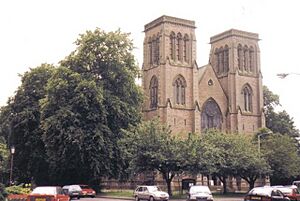
Important buildings in Inverness include Inverness Castle and several churches. The castle was built in 1835 on the site of an older medieval castle. Until 2020, it housed the Inverness Sheriff Court.
Inverness Cathedral, dedicated to St Andrew, is a beautiful church with unique square-topped spires because funds ran out before they could be completed.
The oldest church is the Old High Church, located on St Michael's Mount by the riverside. Its tower dates back to medieval times, making it the oldest building still standing in Inverness.
The city also has two Catholic churches: St Mary's, Inverness, founded in 1837, and St Ninian's, built in the 1960s and 70s.
Sports and Fun in Inverness
Inverness is a great place for sports and outdoor activities.
Walking Trails
The city is connected to three long-distance walking paths:
- The Great Glen Way: This trail goes to Fort William along the Great Glen.
- The John o' Groats Trail: This path follows the coast all the way to John o' Groats.
- The South Loch Ness Trail: This trail connects to Fort Augustus along the southeast side of Loch Ness.
Football and Other Sports
Inverness has a rich football history. Many teams from the city have played in the Highland Football League. In 1994, two local teams, Caledonian and Inverness Thistle, merged to form Inverness Caledonian Thistle. This team went on to reach the Scottish Premier League in 2004 and won the Scottish Cup in 2015.
Clachnacuddin is another local football club that still plays in the Highland League. More recently, Inverness Athletic was founded in 2016.
Highland RFC is the local rugby union club, playing in the Scottish National League Division One.
Shinty, a traditional Scottish sport, is also very popular here. The Camanachd Association, which governs shinty, is based in Inverness. The city often hosts major shinty finals, including the Camanachd Cup Final.
Highland HC is the local hockey team, with both men's and ladies' teams. Inverness Blitz is a charity that promotes American football in the area.
Bught Park, in the centre of Inverness, is the finishing point for the annual Loch Ness Marathon.
In 2011, Inverness hosted the Scottish Open golf tournament at Castle Stuart. Cricket is also played in Inverness, with local teams like Highland CC and Northern Counties.
Famous People from Inverness
Many notable people have come from Inverness:
- John Findlater – A meteorologist and expert in aviation.
- Laura Muir – A world champion runner and Olympic silver medallist.
- Ryan Christie – A footballer who plays for Bournemouth and Scotland.
- Yvette Cooper – A politician who was born in Inverness.
- Karen Gillan – A famous actress known for her roles in Doctor Who and the Guardians of the Galaxy movies.
- Charles Kennedy – A former leader of the Liberal Democrats political party.
- Russell Knox – A professional golfer.
- Ali Smith – A well-known author.
- Jenny Graham – Holds the world record for the fastest woman to cycle around the world.
- Lorne Balfe – A composer who creates music for films, TV, and video games.
Images for kids
See also
 In Spanish: Inverness para niños
In Spanish: Inverness para niños


